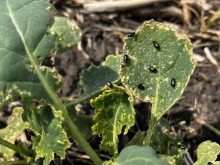Populations of the fast-spreading Palmer amaranth weed have been confirmed in five counties in northwestern Indiana, a Purdue Extension weed specialist says.
At least 50 corn and soybean fields of Jasper, Newton, Pulaski, LaPorte and Cass counties have verified infestations.
Palmer amaranth is a green, flowering plant that has caused widespread damage in cotton production in southern states. Most populations are glyphosate-resistant, and the weed thrives in summer heat, can grow upwards of two inches per day and reach heights greater than seven feet.
Travis Legleiter, Purdue weed science program specialist, said the rapid growth and general hardiness of the weed makes it a problem in corn and soybean fields.
Read Also

Field-by-field mapping could improve yield, productivity predictions
University of Saskatchewan researchers are using field border mapping to collect data on field variability, including problematic weeds, and to predict things like yields.
"Palmer amaranth’s competitiveness is what makes it a concern for us," he said. "We know from our counterparts in the South how devastating this weed can be to crops. And now we know Palmer amaranth can be competitive in northern geographies, too."
Farmers might be familiar with other amaranth species such as redroot, smooth pigweed or waterhemp. In fact, the confirmed cases were misidentified as waterhemp before farmers noticed that their applications of traditional herbicides such as glyphosate weren’t controlling the problem.
Legleiter said farmers across Indiana should be aware of the Palmer species and know it differs from other species.
"Palmer amaranth does have distinguishing characteristics. The first thing is the length of the petiole, the stalk that joins the leaf and stem. It will be significantly longer, especially on older plants. If you take the petiole and leaf blade and fold them over, the petiole is longer on Palmer amaranth."
The plant is hairless and has multiple seed heads, with one terminal, female spiny seed head that’s 3-4 feet long and can produce 500,000 seeds.
Farmers should use pre-emergent herbicides on both corn and soybean fields. Some post-emerge herbicides can help farmers with infestations in corn fields, but those with soybeans must start with a clean field the next season and use the pre-emerge herbicides.



















